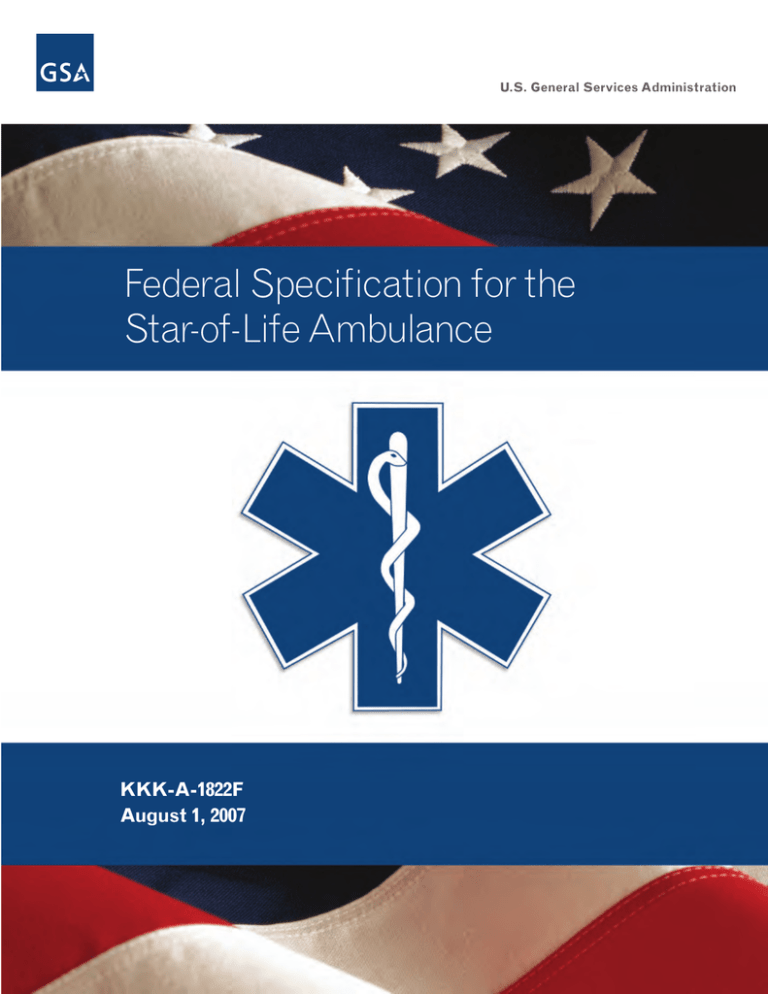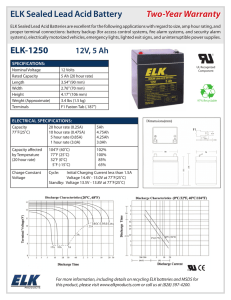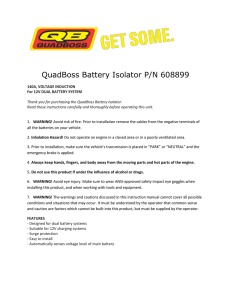Federal Specification for the Star-of-Life Ambulance
advertisement

U.S. General Services Administration Federal Specification for the Star-of-Life Ambulance KKK-A-1822F August 1, 2007 TABLE OF CONTENTS 1. SCOPE, PURPOSE, AND CLASSIFICATION . . . . . . . . . . . . . . 1 2. APPLICABLE DOCUMENTS . . . . . . . . . . . . . . . . . . . . . . . . . . . . . . . . 3 3. REQUIREMENTS. . . . . . . . . . . . . . . . . . . . . . . . . . . . . . . . . . . . . . . . . . . . . 6 4. QUALITY ASSURANCE PROVISIONS . . . . . . . . . . . . . . . . . . . . . 55 5. DELIVERY . . . . . . . . . . . . . . . . . . . . . . . . . . . . . . . . . . . . . . . . . . . . . . . . . . . . 58 6. NOTES . . . . . . . . . . . . . . . . . . . . . . . . . . . . . . . . . . . . . . . . . . . . . . . . . . . . . . . 59 Table 1: Emergency Lighting . . . . . . . . . . . . . . . . . . . . . . . . . . . . . . . . . . . . . . . . . 24 Figure 1: Certification & Payload Signage . . . . . . . . . . . . . . . . . . . . . . . . . . . . . . 62 Figure 2: Payload Calculation Form . . . . . . . . . . . . . . . . . . . . . . . . . . . . . . . . . . . . 63 Figure 3: 12-Volt DC Electrical System . . . . . . . . . . . . . . . . . . . . . . . . . . . . . . . . . 64 Figure 4: 125-Volt AC Electrical System . . . . . . . . . . . . . . . . . . . . . . . . . . . . . . . . 65 Figure 5: Portable Equipment Battery Charging Circuit . . . . . . . . . . . . . . . . . . 66 ii The generating system shall supply the maximum electrical load, at the regulated voltage, at 200°F under hood temperature, and with an engine speed not exceeding of the furnished engine manufacturer’s high idle setting in order to maintain battery charge at the regulated voltage. The throttle control device shall control the engine RPM necessary to maintain the heating and air conditioning systems, at full operating capacity, and to maintain the generating system’s required output when the vehicle is stationary and the parking brake is set. The 12-volt electrical system shall incorporate a voltmeter and low voltage warning device which is functionally connected as shown in Figure 3. The FSAM shall test each ambulance prior to delivery and provide, to the purchaser, a written certification indicating the amount of generating capacity remaining, at the regulated voltage, at 200°F, after supplying the total electrical load as manufactured (including the purchaser options). 3.7.6.1 ENGINE HIGH-IDLE SPEED CONTROL. The OEM Engine High-Idle speed control shall be furnished. The control shall be set to automatically increase the engine speed (RPM) to the engine manufacturer’s recommended setting to sustain the ambulance’s total continuous electrical load at the regulated voltage and provide maximum heating/air conditioning output. The device shall operate only when switched to the “ON” position and the transmission is in “PARK” or “NEUTRAL.” The parking brake shall be applied at all times when the Engine High-Idle speed control is in use. The device shall disengage high idle operation according to OEM and/or engine manufacturer disablement strategy, or if not specified, when the operator depresses the service brake pedal or the transmission is placed in gear. 3.7.6.2 VOLTMETER AND VOLTAGE MONITOR. A voltmeter illuminated for nighttime operation shall be furnished. The electrical system shall be monitored by a system that provides an audible and visual warning in case of the low voltage to persons in the ambulance of an impending electrical system failure caused by the excessive discharge of the batteries. The charge status of the battery shall be determined by direct measurement of the battery voltage. The alarm shall sound if the system voltage at the battery drops below 11.8 V for 12 V nominal systems for more than 120 seconds. 3.7.7 BATTERY SYSTEM. Two batteries (or additional batteries as required by the OEM) for ambulance use shall be furnished. The batteries shall be equivalent to the OEM batteries. Batteries shall be located in a ventilated area, sealed off from occupant compartments, and shall be readily accessible for servicing and removal. When batteries are mounted in the engine compartment, they shall be provided with a heat shield as a safeguard against high under hood temperatures when relocating batteries; the OEM shall approve the method of relocation. 18 3.13.3 AIR CONDITIONING CRITERIA. The air conditioning system(s) will have sufficient capacity to maintain the temperature in the patient compartment at a maximum dry bulb temperature of 78°F. When available, OEMs’ interconnection points will be utilized. 3.13.4 VENTILATION CRITERIA. Ventilation system(s) of the driver and patient compartments will provide a complete change of ambient air within both compartments at least every two minutes with the vehicle stationary. Ventilation will be separately controlled within the cab and patient compartments. Fresh air intakes will be located towards the front of the vehicle and exhaust vents will be located on the upper rear of the vehicle. Exhaust vents may be located on the rear lower half of the module/body, provided the vent/device incorporates a reverse flow damper to prevent back draft and intrusion of vehicle engine exhaust, dust, dirt, or road spray. The patient compartment will be ventilated by the air delivery system of the environmental equipment (heater-air conditioner) or by separate system(s), such as power intake, exhaust ventilator(s). 3.13.5 ENVIRONMENTAL CONTROLS. Adjustable, manual or thermostatically operative controls will permit heating and/or air conditioning and ventilation in either compartment without affecting the other compartment. Switches and controls will be located in “action area” panel and/or remote panel and identified for function and operating position. Blower or fan system will have at least three speeds (excluding “OFF”). Separate non-corroding brass, bronze, stainless steel, plastic or other inherently corrosion proof shutoff valves, for the patient compartment hot water heating system, will be provided. The use of vacuum or electrically operated shutoff valves is acceptable provided it will meet the above criteria and the valve provides inherent sealing when vacuum is removed. This sealing will prevent engine cooling system pressure and water pump pressure from causing any leakage when vacuum is removed. Air systems will have adjustable louvers to direct the flow of air. 3.13.6 PATIENT COMPARTMENT SOUND LEVEL CRITERIA. The patient compartment sound level shall not exceed 80 dBA at any time. 3.14 COMMUNICATIONS. 3.14.1 COMMUNICATION EQUIPMENT. Any two way radio equipment shall be installed by a licensed installer approved by the radio manufacturer. Communications equipment will meet the applicable FCC rules and required state and local area EMS radio communication protocols. 3.14.2 RADIO (MOBILE) PROVISIONS. All ambulances will be provided with sufficient ventilated space for a two-way radio (including convenience features), antenna openings, ground plane, terminal wiring for 12V power and ground. 37


